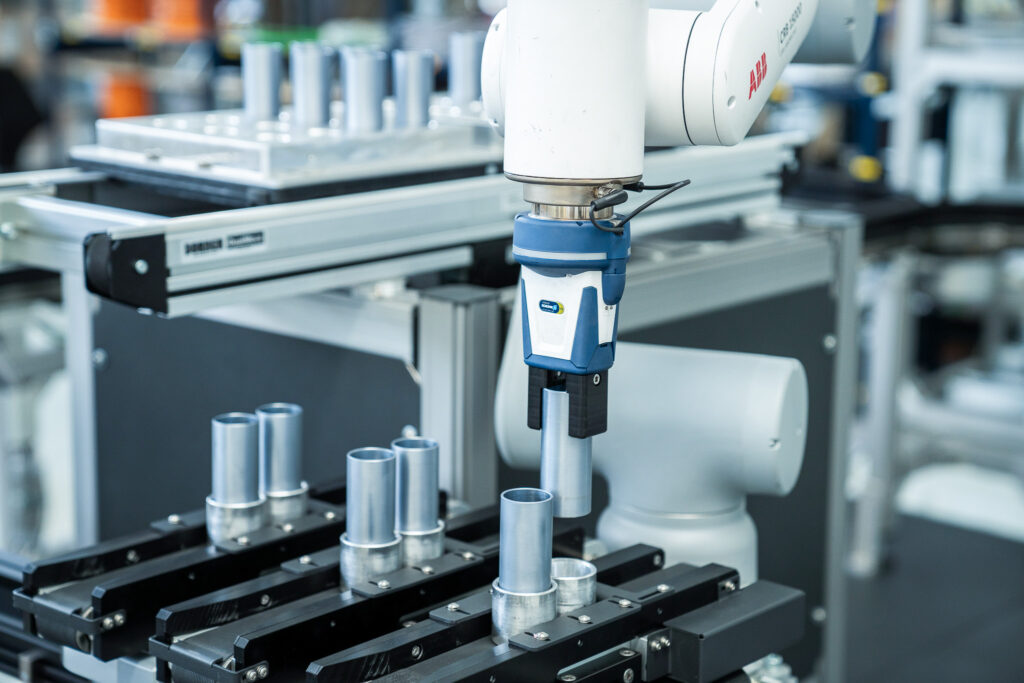The production of lithium-ion batteries is a highly specialized, multi-phase process that demands precision, cleanliness, and efficiency at every step. From raw material handling to final pack assembly, manufacturers must navigate strict environmental controls, high throughput demands, and the need for flexible automation. Conveyance systems from Dorner, montratec, and Garvey play a vital role in supporting each stage of this process, ensuring smooth, contamination-free, and efficient material flow.
Electrode Manufacturing
Battery production begins with the preparation of electrode materials. Raw powders such as lithium, graphite, and binders are mixed into a slurry in a tightly controlled environment. These materials must be conveyed from storage to mixing stations without introducing contaminants. Dorner’s stainless-steel conveyors, designed for hygienic and easy-to-clean operation, are ideal for this stage. Their precision coupled with their ability to handle rugged operations allows for battery manufacturers to ensure their products are being conveyed no matter the environment.

Once mixed, the slurry is coated onto metal foils and dried in long ovens. These coated foils are then calendered (pressed) to achieve the desired thickness and consistency. After pressing, the foils are slit into narrower rolls and notched into electrode shapes.
Cell Assembly
The next phase is cell assembly, which varies depending on the battery format—cylindrical or pouch.

For cylindrical cells, the anode and cathode foils are wound into a jelly roll, which is then welded, insulated, and inserted into a metal canister. This process requires precise handling of both the jelly roll and the can. Dorner’s FlexMove conveyors are well-suited for transporting these components between winding, welding, and canning stations. Their smooth, controlled motion helps prevent damage to sensitive materials and supports high-speed automation. The can handling and distribution of this process can be done with a Garvey accumulation table, which can single file and properly distribute the cans to the next step in the process.
In pouch cell production, the foils are stacked or folded with separator sheets before being sealed into flexible pouches. The montrac shuttle system and Dorner’s pallet systems excel in this environment, offering clean, programmable transport in the assembly processes of stacking, folding, and sealing stations. Their ability to operate in dry rooms with dew points as low as -50°C makes them indispensable for electrolyte filling and sealing, where moisture control is critical.
Electrolyte Filling and Formation
Once assembled, cells are filled with electrolyte, a highly sensitive step that must occur in ultra-dry environments. Conveyance systems must be designed to operate in conditions ranging from -25°C to -70°C dew points. montratec’s shuttle systems maintain environmental integrity while moving cells between filling, sealing, and formation stations. These systems can also be integrated with sensors to monitor humidity and temperature in real time.
Formation involves charging and discharging the cells to activate the electrochemical materials. This step is followed by aging and degassing. Conveyors must be able to handle large volumes of cells while maintaining traceability and minimizing handling errors. Garvey’s puck-based accumulation systems are ideal for this stage. Each battery cell is placed on a puck, allowing for precise, individual handling and buffering between formation and testing stations. This approach supports high throughput while minimizing the risk of damage or contamination.
Pack Assembly
After individual cells are tested and sorted, they are assembled into modules and packs. This stage involves connecting cells electrically, assembling them into structural modules, and integrating wiring and thermal management systems. The components are larger and heavier at this point, requiring robust and flexible conveyance solutions.
Dorner’s heavy-duty pallet conveyors are commonly used to move modules through wiring, inspection, and final assembly stations. Their precision-focused design makes them ideal for robotic interaction and for operations that have high weight applications.
Finally, in facilities where space is limited or cleanroom zoning is critical, montratec’s ceiling-mounted shuttle systems are deployed to transport modules between floors or across long distances without disrupting other operations. The energy efficient drive components of montrac® shuttles ensure low energy consumption and efficient operation even when transporting product throughout large facilities.
One Provider for Battery Transport
Dorner, montratec, and Garvey all offer solutions that meet these requirements. Their systems are built to operate reliably in cleanroom and dry room environments, ensuring that product integrity is never compromised. Whether it’s the hygienic transport of raw materials, the precise handling of delicate foils, or the buffering of finished cells, these conveyance technologies are essential to modern battery manufacturing.




